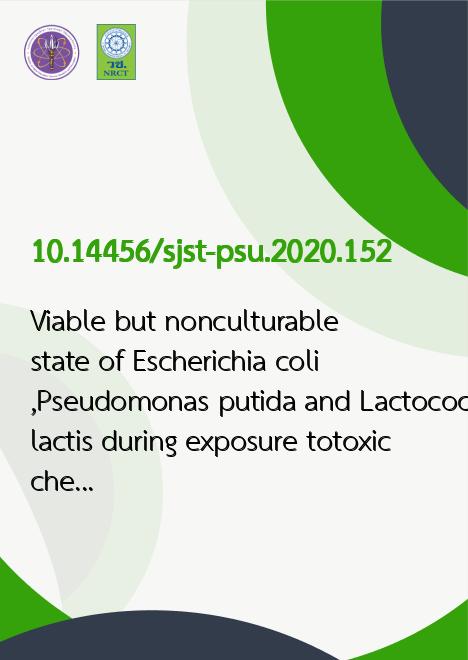
|
Viable but nonculturable state of Escherichia coli,Pseudomonas putida and Lactococcus lactis during exposure totoxic chemicals, as revealed by headspace gas chromatographyand indirect conductivity techniques |
|---|---|
| รหัสดีโอไอ | |
| Creator | 1. Panwajee Payongsri 2. Nattapat Charoenrat 3. Thunyarat Pongtharangkul 4. Jirarut Wongkongkatep |
| Title | Viable but nonculturable state of Escherichia coli,Pseudomonas putida and Lactococcus lactis during exposure totoxic chemicals, as revealed by headspace gas chromatographyand indirect conductivity techniques |
| Publisher | Research and Development Office, Prince of Songkla University |
| Publication Year | 2563 |
| Journal Title | Songklanakarin Journal of Science and Technology |
| Journal Vol. | 42 |
| Journal No. | 6 |
| Page no. | 1164-1170 |
| Keyword | gas chromatography, indirect conductivity, metabolic activity, viable but nonculturable (VBNC), emulsion |
| URL Website | https://rdo.psu.ac.th/sjstweb/index.php |
| ISSN | 0125-3395 |
| Abstract | The bioconversion of water-immiscible chemicals by microbes may occur through viable but nonculturable cells(VBNC) and the evaluation of such cellular activity is important for a deeper understanding of the metabolic process. In thisstudy, the metabolic CO2 production in a bacteria interface emulsion, consisting of bacteria, chitosan and solvent, has beenmonitored using headspace gas chromatography (GC) and indirect conductivity (IC). The results from GC in comparison to thestandard culture technique revealed the presence of VBNC state when E. coli DH5? and P. putida F1 were in contact with nhexane. L. lactis IO-1 was the most sensitive strain, but the VBNC cells were obvious in the case of soybean and n-decane.Although GC showed better detection sensitivity, the IC technique was more practical and cost-effective. Therefore, GC and ICcould be extremely simple and useful methods for monitoring the VBNC state of bacteria, which generally stems fromenvironmental stresses. |
